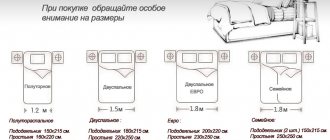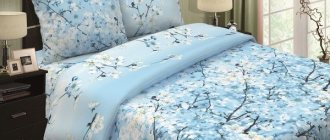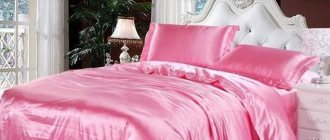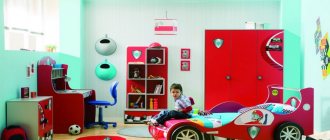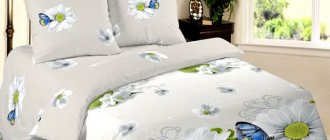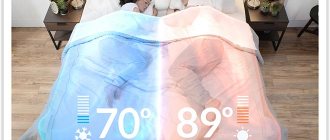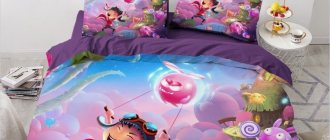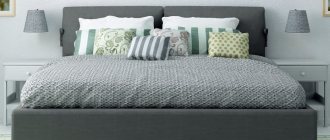What kind of bedding should be for a child?
When organizing a child's bed, the main task of parents is to ensure healthy sleep for the child and a comfortable atmosphere conducive to rest. The correct selection of bedding plays an important role. Lingerie should not only be of high quality, suitable in size, but also evoke a pleasant feeling in the baby.
When choosing fabrics, the baby's mother will be able to choose good quality material, desired colors and patterns.
Note! It is recommended to avoid too bright colors when sewing baby bedding for a newborn crib with your own hands. Contrasting shades can cause aggression and anxiety. It is better to give preference to neutral, calm shades.
How much fabric do you need for a family bedding set?
The main parameters of bedding are as follows:
| Pillowcases | 70x70 cm; 70x50 cm. |
| Duvet covers (2 pieces) | 210x145 cm. |
| sheet | 240x220 cm. |
You should try to choose a fabric whose width is 220 cm. You need to purchase 980 cm of material.
Sewing children's bed linen
The sewing process is not complicated. It does not require special skills. You should start by measuring the sleeping area. This is necessary for correct fabric calculation. Next, you will need to prepare the following set of sewing tools and accessories:
- Main fabric and thicker material for sides;
- Well-sharpened tailor's scissors;
- Tape measure;
- Pins or bobby pins;
- Chalk or bar of soap;
- Threads;
- Long ruler;
- Iron;
- Sewing machine.
How much fabric do you need for a Euro bed linen set?
The main parameters of bedding are as follows:
| Pillowcases | 70x70 cm; 70x50 cm. |
| Duvet cover | 220x200 cm. |
| sheet | 220x200 cm. |
It is advisable to choose a fabric with a width of 2200 mm and purchase a 7.45-meter piece.
Selection of fabric and selection of bed linen design
When choosing fabric for children's bedding, the first thing you need to pay attention to is its composition. It should be completely natural, breathable. Preference should be given to hypoallergenic and environmentally friendly materials that are easy to care for.
This option will be a “lifesaver” if the bed has a non-standard size and it is not possible to buy bedding that fits the size.
The best option is cotton. Depending on the density and method of weaving the threads, you can choose a fabric for both summer and winter use.
This is also a good motivation for using your skills in handicrafts or for mastering something new and useful.
Types of natural and hypoallergenic fabrics:
- Chintz. Soft, tactilely pleasant material. Due to its thinness, it has good breathability and moisture-absorbing properties. Does not require special care measures. The disadvantages include low wear resistance.
- Calico. One of the most popular options. It is highly durable and does not interfere with air circulation. Disadvantage: rougher to the touch.
- Satin. It has many advantages: it does not wrinkle, does not accumulate static electricity, and has good thermal conductivity. A preferred option for summer, as the material creates a cooling effect. Satin is wear-resistant and easy to care for: it does not wrinkle, maintaining the same appearance from wash to wash.
- Linen. It is characterized by moisture absorption properties, breathability, and thermal conductivity. It is worth considering that linen is quite hard. Disadvantages include high cost and the need for more delicate care.
- Bamboo. The material has high strength and antimicrobial properties. Absorbs moisture well and neutralizes foreign odors. Cons: high price.
Important advice! When selecting fabric for sewing children's bedding, it is advisable to give preference to satin or bamboo. These materials are durable and easy to maintain. They will promote comfortable sleep by absorbing moisture and allowing free air circulation.
When choosing a design, it is important to consider the age and gender of the child. Girls most often prefer delicate pastel shades: peach, yellow, pink or lilac. Young guys, on the contrary, choose contrasting, rich colors: deep blue, purple or green. 3D prints are popular, which can depict your favorite characters from cartoons and fairy tales. Such underwear develops the child’s imagination and helps to fantasize.
It is necessary to consider only high-quality, natural fabric.
Material consumption for sewing bedding for newborns
They sew bedding for a newborn only from natural fabrics, mainly cotton: chintz, satin, flannel. To sew a sheet, pillowcase, duvet cover, you will need approximately 3 m 90 cm of fabric with a width of 150 cm.
How to choose the right bed linen based on fabric composition, see here.
Fabric consumption when sewing
In order for the pattern of children's bedding to meet the required dimensions, you will need to accurately calculate the required amount of fabric. The easiest way to do this is by measuring the existing kit. If there is none, you need to measure each element: pillows, mattress and blanket.
The best option would be 100% cotton fabric. Cotton bed linen is suitable for both summer and winter.
Taking into account the space for hems and seams, the following should be additionally added to the measurements obtained:
- For a duvet cover - 5 cm on each side;
- For sheets - 10 cm;
- For pillowcases – 4 cm;
Important! We must not forget about the shrinkage percentage of any material when calculating how much fabric is needed for a set of children's bedding for a crib. This information must be indicated on the packaging. Typically, the shrinkage rate varies from 1.5 to 3%. Washing and ironing should be done before cutting.
Preliminary actions
Before calculating the required amount of fabric for bedding, you must correctly measure the bed, blanket and pillows. The quality of sewn bedding and their comfort will depend on the reliability of the measurements.
Basic recommendations to follow:
- To avoid making a mistake, you need to take old bed linen, measure its parameters and add 6 centimeters to each side (seam allowances).
- To purchase the correct cut for a duvet cover, you need to carefully determine the parameters of the duvet and add 8 centimeters to each side. The blanket in the duvet cover should be loose, not constrained.
- Determining the parameters of a sheet must be taken seriously. It should not be too small, and there is no need to hang down to the floor. Therefore, for accurate calculations, not only the width of the mattress is taken, but also its height. All indicators are summed up, and from 20 to 40 centimeters on each side are added to the result obtained.
- To sew pillowcases correctly, you need to measure the length and width of the pillow. Sewing pillowcases involves having a large bend or sewing in a zipper. For bending, 30 centimeters are added. For lightning, 6–7 centimeters is enough.
Fabric consumption for bedding of different sizes
After receiving all the results (sheets, pillowcases and duvet covers), they are summed up, and a piece of the selected fabric is purchased.
Step-by-step sewing instructions
After preparing the necessary tools and materials, you can begin the process of cutting and sewing each element. Upon completion of all stages, you will need to iron and steam the finished products.
Pillowcases
For newborns, it is recommended to choose a pillowcase model with a valve. Standard size – 50 x 70 cm.
- Measure the required piece from the original fabric, leaving allowances for seams and 30 cm for the flap, as indicated in the diagram. Fold the resulting cut right side inward.
- Edges that are not finished with a factory seam should be sewn using a sewing machine.
- Fold the 30 cm calculated for the valve upward. Thanks to this, the pillow will be securely fixed inside the pillowcase.
- Fold the sides flat and stitch. First, make seams on the front side, then on the back. This will ensure high strength of the product.
When the pillowcase is ready, it will need to be ironed with a steam iron.
Sheets
A standard sheet will be sewn simply and quickly:
- Measure and cut a piece of the desired size, leaving seam allowances.
- Fold each raw edge inward once (for a machine without an overlocker - 2 times), stitch. If the factory finishing of the edges is of poor quality, it is recommended to stitch them.
The process of sewing a sheet with an elastic band:
- Measure and cut a piece measuring 150 x 120 cm.
- Fold it 4 times.
- Measure a piece of 20 x 20 cm in the upper right corner and cut it out.
- Sew all edges without factory processing, overlock the corners.
- Place the cut sides right sides together as shown in the diagram. Baste them with a closed hem and stitch.
- Hem all sides, remembering to leave room for elastic. Insert it and stretch it around the entire perimeter of the product.
- Sew all edges.
It is more difficult to sew a sheet with an elastic band, but if you follow the instructions, everything will work out.
duvet cover
- Fold all raw edges under and stitch.
- Fold the pattern in half with the right sides facing in.
- Sew the top and sides of the duvet cover.
- Visually divide the lower part into 3 parts: two side parts of 40 cm and a central part of 20 cm (hole for inserting a blanket).
- Sew the sides, leaving a central hole. Turn the product inside out.
It is important to place the blanket in the prepared piece of fabric in advance and determine that the duvet cover fits the size of the blanket.
Sides for the crib
Soft sides will protect the baby from damage. To make them, you will need to choose a denser fabric. As a filler you can use synthetic winterizer, foam rubber or holofiber.
- The pattern will have a rectangular shape. For long sides you will need pieces measuring 120 x 40 cm, for short sides - 60 x 40 cm.
- Sew all raw edges.
- Sew a strong braid or ribbon to each corner. With its help, the side will be attached to the playpen.
- Cut the filling according to the size of the patterns.
- Insert filler and sew each piece.
- You can sew a hidden zipper into one of the sides. This will allow you to remove the filling before washing.
You can sew covers for the sides, which will need to be removed and washed from time to time.
How to sew bedding for a crib with your own hands
Before you start sewing, you need to prepare all the necessary tools:
- Fabric, the width of which will be from one and a half meters with a length of four meters;
- Dense material for sides;
- Thread and needle;
- Sewing machine;
- Scissors and pins;
- Tape and ruler;
- Crayons or remnants;
- Foam rubber and iron.
In addition, you need a good mood and free time. The work done in a hurry will have the appropriate quality.
Cutting is just as important as sewing
Pillowcases
Sewing a pillowcase is simple, but you need to be precise. To do this, you need to fold the pattern and follow the instructions:
- Measure a piece of fabric measuring 70 by 50 cm from the canvas and fold it with the right side inward;
Pillowcase pattern
- The 30 cm corner that remains from cutting should be folded to the top to create a valve that prevents the pillow from falling out of the pillowcase;
- Fold the sides and stitch them first along the front side, and then along the back;
- It is advisable to steam the finished product and iron it.
You may be interested in this: Patterns and sewing procedure for a pleated skirt
Ready product
sheet
The sheet is made using several methods: with elastic and in the usual way. For the first method, the step-by-step instructions are as follows:
- Cut a piece of fabric and allow an allowance of a couple of centimeters on each side. The result will be a piece 145 in length and 115 in width;
- Fold the fabric over each side once or twice and begin stitching. The processed edges do not look very nice, so they can also be hemmed;
- The product should also be ironed, especially the edges.
Pattern for sewing sheets
The second type of sheets is suitable for active kids. It is more difficult to sew, but following the instructions, everything will work out:
- Cut the fabric 120 by 150 cm;
- Fold it four times and measure a 20 by 20 square in the upper right corner;
- Cut it off with scissors, and then stitch the corners and turn them over;
- Hem all sides, taking into account space for the elastic, which will be threaded later;
- Insert the elastic into the sheet and stretch it all the way around, then hem it.
Important! The fitted sheet should fit tightly, but not tightly, onto the mattress so that it cannot be brushed off by simply turning the body. If it does not fit, then you need to replace the elastic band with a longer one or, conversely, hem it if the sheet falls off.
Bed sheet with elastic band
Duvet cover
To make it, you need a piece measuring 210 by 290 cm. You should immediately try it on the blanket and make sure that it fits there. The next steps are:
- Fold the fabric in half and work the top and bottom;
- 40–50 cm of fabric are left on the sides for a hole for inserting a blanket;
- Cover the hole with tape or treat it as desired;
- Iron the product and straighten all corners and seams.
Ready-made duvet cover, sewn yourself
Bumpers for the crib
The bumpers are a useful thing that can protect children from hitting the bed rods. To make them, you need thicker fabric, which you need to buy separately. You can make it as follows:
- Make a pattern for rectangular sides. Fabrics are cut 40 by 60 along the length of the bed, 40 by 120 along the width;
- Finish the edges by sewing braid or ribbons to them to tie them to the beds;
- Turn the sides inside out and fill them with foam rubber for softness;
- Sew a zipper into each product to remove the foam when washing;
- Lay out and strengthen the sides along the bed.
You might be interested in Sew without patterns: dress therapy with Julia
Bumpers on the crib
How to decorate baby bedding
The sides can be decorated at the sewing stage using leftover fabric. To do this, you need to prepare a strip about 180 cm long and 7 cm wide. Place the frill, gathering it, inside the product, and sew the edges.
The sheet can be decorated with flounces from the remaining material, sewing them on all sides. Any element of linen can be decorated with delicate lace, large woven ruffles or soft ribbons.
How much fabric do you need for a double bedding set?
It is generally accepted that such a kit has the following data:
| Pillowcases (2 pieces) | 70x70 cm; 70x50 cm; 60x60 cm. |
| Duvet cover | 180x210 cm; 176x214 cm; 200x220 cm. |
| Sheet | 230x240 cm; 215x220 cm; 180x215 cm; 175x210 cm. |
This variety of parameters is due to the fact that different manufacturers from different countries use their own system of measures. Moreover, the beds offered by sellers also differ in parameters, and this must be taken into account when purchasing a piece of fabric.
To avoid mistakes, you need to do the following (taking into account a fabric width of 2200 mm):
- For a duvet cover, take into account the dimensions of the blanket and add 6-7 centimeters on each side (at the seams). Example: 1800 mm (duvet cover width) x 20 + 70 mm = 3670 mm.
- Bed sheet. Take the width of the bed (150 cm), add 40 centimeters on each side and multiply by 2. The result is 230 cm (including folds).
- Pillowcases. The width of the fabric is enough to cut out two pillowcases. We take as a base a pillowcase 70 cm by 70 cm. The formula is as follows: 70 x 2 + 30 cm (on the flap) + 7 cm (on the hem) = 177 cm. If you decide to insert a zipper, then the length of the sheet is reduced by 25 centimeters.
Tips for sewing a bedding set
An important piece of advice is to avoid embossed, voluminous decor. Small parts such as buttons, zippers or Velcro can be harmful to your baby's health. You should not use adhesive applications - they are not practical and can come off during washing.
The linen should be free of any textured decor - locks, zippers, Velcro, snaps, buttons.
By following the detailed instructions, you can sew a set of underwear for your baby without spending a lot of time. The main thing is to remember that children's bedding should be safe, practical and functional.
Even parents with minimal knowledge in the field of needlework can sew bedding for a baby.

